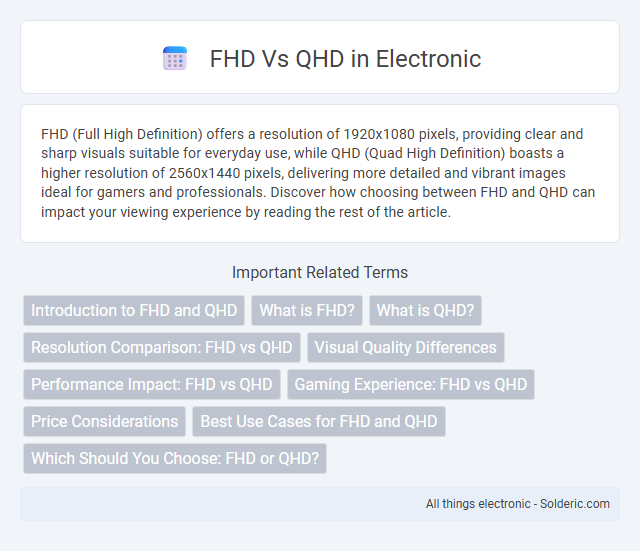FHD (Full High Definition) offers a resolution of 1920x1080 pixels, providing clear and sharp visuals suitable for everyday use, while QHD (Quad High Definition) boasts a higher resolution of 2560x1440 pixels, delivering more detailed and vibrant images ideal for gamers and professionals. Discover how choosing between FHD and QHD can impact your viewing experience by reading the rest of the article.
Comparison Table
| Feature | FHD (Full High Definition) | QHD (Quad High Definition) |
|---|---|---|
| Resolution | 1920 x 1080 pixels | 2560 x 1440 pixels |
| Pixel Density | ~100-110 PPI (depends on screen size) | ~150-160 PPI (depends on screen size) |
| Image Sharpness | Standard clarity suitable for most uses | Sharper images with more details |
| Usage | Budget monitors, general use, laptops, TV | Gaming, professional work, high-end monitors |
| Performance Impact | Lower GPU demand | Higher GPU demand for rendering |
| Price | More affordable | Generally more expensive |
Introduction to FHD and QHD
FHD (Full High Definition) offers a resolution of 1920x1080 pixels, delivering clear and sharp images suitable for most everyday uses, including gaming, streaming, and office work. QHD (Quad High Definition), with a resolution of 2560x1440 pixels, provides significantly higher pixel density for enhanced detail and clarity, ideal for graphic-intensive tasks and professional use. Your choice between FHD and QHD depends on the need for image sharpness and screen real estate versus performance and power consumption.
What is FHD?
FHD, or Full High Definition, refers to a display resolution of 1920 x 1080 pixels, providing clear and sharp visuals suitable for most everyday tasks such as streaming videos, gaming, and office work. This 1080p resolution offers a balanced combination of image quality and system performance, making it widely popular among laptops, monitors, and televisions. Understanding FHD can help you choose the right screen based on your needs, especially when comparing it to higher resolutions like QHD.
What is QHD?
QHD, or Quad High Definition, offers a resolution of 2560x1440 pixels, providing four times the pixels of standard 720p HD. This higher pixel density results in sharper images and more detailed visuals compared to Full HD (1920x1080 pixels). QHD is commonly used in premium monitors, smartphones, and gaming displays to enhance clarity and screen real estate.
Resolution Comparison: FHD vs QHD
FHD (Full High Definition) offers a resolution of 1920x1080 pixels, delivering clear and sharp images suitable for most standard displays. QHD (Quad High Definition) provides a higher resolution of 2560x1440 pixels, resulting in greater pixel density and crisper visuals, especially noticeable on larger screens or when multitasking. The increased resolution of QHD enhances detail and screen real estate, making it ideal for gaming, professional work, and media consumption compared to FHD.
Visual Quality Differences
QHD offers a higher resolution of 2560x1440 pixels compared to FHD's 1920x1080 pixels, resulting in sharper and more detailed images. The increased pixel density in QHD enhances visual clarity, making it ideal for tasks requiring precision, such as graphic design and gaming. You will notice crisper text and more vibrant visuals on QHD displays, providing a superior viewing experience than FHD.
Performance Impact: FHD vs QHD
Choosing between FHD (1920x1080) and QHD (2560x1440) impacts performance primarily in terms of graphical processing load. QHD requires your GPU to render approximately 1.77 times more pixels than FHD, which can result in lower frame rates and increased power consumption during gaming or graphic-intensive tasks. Your device's hardware capability determines whether you can enjoy the enhanced sharpness of QHD without significant performance drops.
Gaming Experience: FHD vs QHD
QHD resolution offers a sharper and more immersive gaming experience compared to FHD, with 2560x1440 pixels delivering clearer details and smoother textures. Higher pixel density in QHD enhances visual clarity, allowing you to spot in-game elements more easily and enjoy richer environments. While FHD at 1920x1080 is less demanding on hardware, QHD strikes a balance between performance and visual quality for gamers seeking enhanced realism.
Price Considerations
FHD (1920x1080) displays are typically more affordable, making them a popular choice for budget-conscious consumers seeking good performance without high costs. QHD (2560x1440) screens, offering higher resolution and sharper images, come at a premium price due to advanced panel technology and enhanced visual quality. The price gap between FHD and QHD varies depending on brand, size, and additional features such as refresh rate and color accuracy, influencing overall value for money.
Best Use Cases for FHD and QHD
FHD (1920x1080) displays are best suited for everyday use such as web browsing, office work, and streaming videos where balanced performance and affordability matter. QHD (2560x1440) screens offer sharper visuals ideal for gaming, professional photo and video editing, and multitasking with multiple windows open simultaneously. Your choice between FHD and QHD should depend on whether you prioritize higher resolution for enhanced detail or lower resolution for better battery life and cost efficiency.
Which Should You Choose: FHD or QHD?
FHD (1920x1080) offers solid clarity and lower power consumption, making it ideal for budget-friendly setups and everyday use. QHD (2560x1440) provides sharper images and greater detail, enhancing your experience in gaming, professional design, and media consumption. Choose QHD if your priority is higher resolution and improved visual quality, while FHD suits those seeking better performance efficiency and affordability.
FHD vs QHD Infographic

 solderic.com
solderic.com